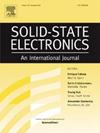3D(微/纳米)CdO/p-Si共掺杂Zn和La异质结可作为太阳能光电探测器
IF 1.4
4区 物理与天体物理
Q3 ENGINEERING, ELECTRICAL & ELECTRONIC
引用次数: 0
摘要
氧化镉是最吸引人的材料之一,因为它可以用于各种应用,包括光电探测器。采用溶胶-凝胶自旋涂层技术制备了Al/La-Zn/共掺杂CdO/p型Si/Al光电探测器,其中CdO界面层具有不同浓度的La(0.1、0.5、2和4 at%)和恒定浓度的Zn (1 at%)。每个薄膜都生长在玻璃和硅衬底上,这样就可以评估它们的光学和电学性能。分析了透明共掺杂CdO光电探测器的形态、光学和电学性能。利用场发射扫描电镜和能量色散x射线分析了制备材料的形态特征和元素组成。FESEM图像显示了La/Zn-co-CdO形式的三维微纳米结构,其特征是利用纳米针形成微球。此外,还观察到CdO与La-Zn共掺杂抑制了薄膜的显影速度。透射率测试表明,所制备的薄膜在可见光光谱上的透射率为40% ~ 70%。通过线性拟合测量了薄膜的光学带隙,其中随La-Zn共掺杂浓度的增加而线性增加,其范围在(2.07 ~ 2.27 eV)之间。当CdO与La (0.1 at%)和Zn (1 at%)共掺杂时,所制备的光电探测器的I-V特性显示出高整流行为。显示了其光伏和光电行为,以及相关参数。此外,掺杂剂浓度(La 0.1和Zn 1)为%时的光响应行为最高,约为4085,超过了前人的研究结果。测定了La 0.1和Zn 1在%时的最高光敏度为6.3 × 10−4。强整流特性以及光伏、光电和光响应特性表明,制备的l0.1和zn1共掺杂的cdo光电探测器适合光电应用,特别是在传感器和光电探测器中。本文章由计算机程序翻译,如有差异,请以英文原文为准。
3D (micro/nano) CdO/p-Si co-doped Zn and La heterojunctions perform as solar light photodetectors
Cadmium oxide is among the most appealing materials since it may be utilized in a variety of applications, including photodetector. Al/La-Zn/co-doped CdO/p-type Si/Al photodetectors were fabricated using the sol–gel spin coat technique, with the CdO interface layer, varying concentrations of La (0.1, 0.5, 2, and 4 at%), and constant Zn (1 at%). Each film was grown on glass and silicon substrates so that their optical and electrical properties could be evaluated. Analyses were conducted on the morphological, optical, and electrical properties of transparent, co-doped CdO photodetectors. Using a field emission scanning electron microscope and energy dispersive X-ray, the morphological properties and elemental compositions of prepared materials The FESEM images revealed a 3-D micro/nanostructure of La/Zn-co-CdO form, characterized by the formation of microspheres by the use of nanoneedles. Additionally, the development rate of the films was observed to be inhibited by the co-doping of CdO with La-Zn. The transmittance measurements show that the prepared films exhibit a ranging from 40 to 70 % in the visible spectrum. The optical bandgap of prepared thin films measured by linear fitting where increases linearly with increasing La-Zn co-dopant concentration and was found in range between (2.07 and 2.27 eV). When CdO was co-doped with La (0.1 at%) and Zn (1 at%), the I-V properties of the produced photodetectors revealed high rectifying behavior. The photovoltaic and photoelectrical behaviors are shown, together with associated parameters. Additionally, the dopant concentration of (La 0.1 and Zn 1) at% has the highest photoresponse behavior at about 4085, surpassing findings in prior research. The highest photosensitivity of 6.3 × 10−4 has been determined for La 0.1 and Zn 1) at%. The strong rectifying characteristics, together with the photovoltaic, photoelectrical, and photoresponse properties, indicate that the fabricated (La 0.1 and Zn 1) at% co-doped CdO-based photodetector is suitable for optoelectronic applications, particularly in sensors and photodetectors.
求助全文
通过发布文献求助,成功后即可免费获取论文全文。
去求助
来源期刊

Solid-state Electronics
物理-工程:电子与电气
CiteScore
3.00
自引率
5.90%
发文量
212
审稿时长
3 months
期刊介绍:
It is the aim of this journal to bring together in one publication outstanding papers reporting new and original work in the following areas: (1) applications of solid-state physics and technology to electronics and optoelectronics, including theory and device design; (2) optical, electrical, morphological characterization techniques and parameter extraction of devices; (3) fabrication of semiconductor devices, and also device-related materials growth, measurement and evaluation; (4) the physics and modeling of submicron and nanoscale microelectronic and optoelectronic devices, including processing, measurement, and performance evaluation; (5) applications of numerical methods to the modeling and simulation of solid-state devices and processes; and (6) nanoscale electronic and optoelectronic devices, photovoltaics, sensors, and MEMS based on semiconductor and alternative electronic materials; (7) synthesis and electrooptical properties of materials for novel devices.
 求助内容:
求助内容: 应助结果提醒方式:
应助结果提醒方式:


